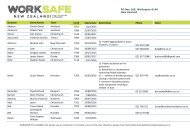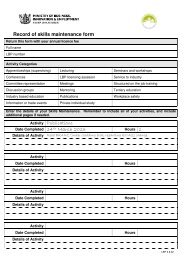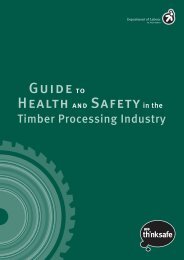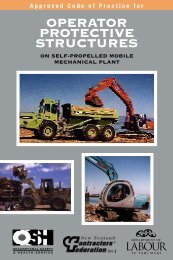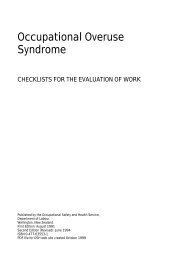Photoengraving and Lithographic Processes ... - Business.govt.nz
Photoengraving and Lithographic Processes ... - Business.govt.nz
Photoengraving and Lithographic Processes ... - Business.govt.nz
You also want an ePaper? Increase the reach of your titles
YUMPU automatically turns print PDFs into web optimized ePapers that Google loves.
NOTICE OF ISSUEI have issued this Approved Code of Practice for <strong>Photoengraving</strong> <strong>and</strong><strong>Lithographic</strong> <strong>Processes</strong>, being a statement of preferred work practices orarrangements for the purpose of ensuring the health <strong>and</strong> safety of persons towhich this code applies <strong>and</strong> persons who may be affected by the activitiescovered by the code.C. J. McKe<strong>nz</strong>ieSecretary of LabourJune 1993PHOTOENGRAVING AND LITHOGRAPHIC PROCESSES 5
FOREWORDI have approved this statement of preferred work practices, which is anApproved Code of Practice for <strong>Photoengraving</strong> <strong>and</strong> <strong>Lithographic</strong> <strong>Processes</strong>,under section 20 of the Health <strong>and</strong> Safety in Employment Act 1992. When acode is approved a Court may have regard to it in relation to compliance withthe relevant sections of the Health <strong>and</strong> Safety in Employment Act. This meansthat if an employer in an industry or using a process to which an approvedcode applies can show compliance with that code in all matters it covers, aCourt may consider this to be compliance with the provisions of the Act towhich the code relates.Hon. Maurice McTigueMinister of LabourJune 19936 PHOTOENGRAVING AND LITHOGRAPHIC PROCESSES
(b) The employer is also required to inform employees of:• The results of any health <strong>and</strong> safety monitoring. In doing so, theprivacy of individual employees must be protected.EMPLOYERS TO INVOLVE EMPLOYEES IN THEDEVELOPMENT OF HEALTH AND SAFETY PROCEDURESEmployers need to ensure that all employees have the opportunity to be fullyinvolved in the development of procedures for the purpose of identifyinghazards <strong>and</strong> dealing significant hazards or dealing with or reacting toemergencies <strong>and</strong> imminent dangers (section 14).TRAINING OF EMPLOYEES AND THE SAFETY OFOTHERSThe employer must ensure employees are either sufficiently experienced to dotheir work safely or are supervised by an experienced person. In addition, theemployee must be adequately trained in the safe use of equipment in theplace of work, including protective clothing <strong>and</strong> equipment (section 13).An employer is also responsible for the health <strong>and</strong> safety of people who arenot employees. An employer must take all practicable steps to ensure that anemployee does not harm any other person while at work, including membersof the public or visitors to the place of work (section 15).EMPLOYEES’ DUTIESIf you are an employee, the Act gives you responsibility for your own safety<strong>and</strong> health while at work. You must also ensure that your actions do not harmanyone else.ACCIDENTS AND SERIOUS HARM (RECORDS ANDNOTIFICATION)The Act defines “accident” as an event that—(a) Causes any person to be harmed; or(b) In different circumstances, might have caused any person to beharmed.This means that “accident” includes both near-misses <strong>and</strong> accidents that resultin harm to a person or might have caused any person to be harmed.Every employer is required to maintain a register of accidents <strong>and</strong> seriousharm; <strong>and</strong> record particulars relating to—(a) Every accident that harmed (or, as the case may be, might haveharmed)(i)Any employee at work; orPHOTOENGRAVING AND LITHOGRAPHIC PROCESSES 9
2.PROCESSES DISCUSSEDIN THIS CODE2.1 BRIEF DESCRIPTIONThe particular process types to which this code of practice applies are as follows:2.1.1 Etching of metal plates, in particular those made of either magnesium orzinc, with a corrosive fluid which is most often nitric acid.2.1.2 Washout of photopolymer plates with an organic chemical as a solvent.The plates may be wholly of photopolymer material <strong>and</strong> hence flexible(e.g. Cyrel process), or they may have a metal backing with aphotopolymer upper layer as the soluble surface (e.g. Nyloprint process).2.1.3 <strong>Lithographic</strong> processes which involve etching with corrosive fluids. It mustbe pointed out that this does not apply to all lithographic processes, butgenerally to the so-called “multi-metal” systems where an upper plate layerof chromium is partially removed by etching to reveal the underlyingcopper or brass layer which provides the image. The deep-etch plateprocess, involving a single metal layer, is a further example of a process inthis category.2.2 RECOMMENDED MEASURES COMMON TO THETHREE PROCESSESThere are a substantial number of recommended control measures which arecommon to the three process types being considered, even though thechemical nature of the hazard is different in each case. Although somerepetition is involved, it is thought advisable to give a complete list, for eachprocess, of the measures considered necessary to combat the known hazardsso that each set of guidelines may st<strong>and</strong> alone.12 PHOTOENGRAVING AND LITHOGRAPHIC PROCESSES
3. BRIEF SUMMARYOF OSH POLICY3.1 POLICY IN RELATION TO PHOTOENGRAVING3.1.1 In photoengraving <strong>and</strong> lithographic processes, the concentration in theworkroom air of vapours which emanate from chemicals either used as partof the process or arising as by-products from the process is the majorst<strong>and</strong>ard to be met. This concentration must be maintained below therelevant WES or, where applicable, at a level which is not “offensive” toworkers.3.1.2 The Act requires “all practicable steps” to be taken to protect employeesfrom inhalation of steams, fumes, dusts, or other impurities which are likelyto be “injurious or offensive”.3.1.3 The WES value is the yardstick used to determine whether or not the airconcentration of a particular contaminant will be injurious to health. Afuller description of the WES concept <strong>and</strong> the measurement of airconcentrations of contaminants is given in Appendix 2, together with a listof current WES for the major chemicals <strong>and</strong> by-products to be encounteredin photoengraving <strong>and</strong> lithography.3.1.4 Because the processes under discussion may vary widely in terms ofchemicals used, concentrations, environmental conditions, <strong>and</strong> equipmentdesign, it follows that it is more appropriate to use the WES as anindication of air contamination <strong>and</strong> consequently of the need for anyremedial action, rather than to set an arbitrary st<strong>and</strong>ard rate of airmovement through the workroom.PHOTOENGRAVING AND LITHOGRAPHIC PROCESSES 13
4. GENERAL PRECAUTIONSAND SAFE WORK METHODS4.1 HANDLING OF ACIDS4.1.1 In processes where acids are used for etching, tasks such as replenishing ofacid supplies must be carried out with due care <strong>and</strong> attention. In particular,adequate protective clothing must be made available by employers, <strong>and</strong>must be worn by employees. Suitable clothing for the job would consist ofPVC (or neoprene) apron <strong>and</strong> gloves, <strong>and</strong> goggles or preferably a full faceshield.4.1.2 In addition, workers should be aware that the basic first aid measure foracid burns on the body is to immediately flush the affected part withcopious quantities of cold running water.4.1.3 On no account should acids or other chemicals be carried about theworkroom in open containers such as buckets. A closed container isessential.4.1.4 Plastic jerrycans used to store concentrated acids will become brittle afterextended storage times <strong>and</strong> may fracture if subjected to mechanical shock.Care must be taken when h<strong>and</strong>ling these containers.4.2 HANDLING OF ORGANIC SOLVENTS4.2.1 Organic solvents such as perchloroethylene <strong>and</strong> trichloroethylene have nocorrosive potential but they do pose a hazard from inhalation of toxicvapour, particularly if a spillage of solvent occurs.4.2.2 Large spills of solvent should be soaked up with absorbent material whichis afterwards removed to an outside site to evaporate. The area of the spillshould be well ventilated to assist in complete evaporation. The persondoing the cleaning up should be supplied with respiratory protection.4.2.3 Rags used for mopping up small-scale spills should be placed in a closedcontainer with a tight-fitting lid or be allowed to evaporate at an outsidesite chosen to minimise the potential nuisance to others.4.2.4 Solvents such as ethyl alcohol or isopropyl alcohol should be h<strong>and</strong>led withdue regard for their flammability. Smoking must be clearly prohibitedwhere flammable solvents are in use.4.2.5 Where non-flammable solvents such as trichloroethylene <strong>and</strong>perchloroethylene are concerned, smoking represents a hazard due to the14 PHOTOENGRAVING AND LITHOGRAPHIC PROCESSES
eakdown of vapours from these solvents into toxic by-products wheninhaled through a lighted cigarette. Again, smoking must be prohibited inareas where trichloroethylene <strong>and</strong> perchloroethylene vapours are likely tobe present.4.2.6 Hot metal surfaces <strong>and</strong> arc welding operations also result in decompositionto form highly toxic by-products, most notably phosgene gas <strong>and</strong>hydrochloric acid. Trichloroethylene forms phosgene in much greaterconcentrations than other chlorinated hydrocarbons <strong>and</strong> hence representsthe greatest hazard in this context. Clearly, welding or excessively hotsurfaces should not be allowed in areas where chlorinated hydrocarbonvapours may be present.4.3 MACHINES HAVING CONDENSING SYSTEMS4.3.1 Certain equipment used in these processes may operate with organicsolvents above room temperatures. In such cases a water-cooled condensermust be part of the design to ensure that solvent vapour is retained withinthe system.4.3.2 A regular check on the condenser water flow rate should be part of normalwork practice. The flow should be adequate to produce normal condensingaction: the best check on this is that the outflowing water should be nowarmer than just tepid to the touch. The company supplying theequipment should be able to advise on an adequate flow rate <strong>and</strong> outflowtemperature.PHOTOENGRAVING AND LITHOGRAPHIC PROCESSES 15
5.ETCHING OF MAGNESIUMAND ZINC PLATES5.1 THE PROCESS.The overall process involves plate pre-treatment, the actual etching by the action ofnitric acid on the metal surface, <strong>and</strong> the final after-washing treatment. The etchingprocess may result in the evolution of nitric acid mist into the atmosphere. A probableby-product of the etching action is the so-called “nitrous” fume, which is in factnitrogen dioxide gas.5.2 CONTROLS.Control of this etching process may be achieved by attention to the following points:5.2.1 The various process steps should, where possible, be located in a separateroom used for no other purpose <strong>and</strong> equipped with a self-closing door (ordoors). The room should be chosen so as to facilitate ventilation to theoutside air, either through an exterior wall if available, or through theceiling, or in some other manner.5.2.2.1 Efficient mechanical exhaust ventilation should be provided on or near theetching bath itself. One appropriate type of ventilation system will beducting of the lip type taking the form of a narrow slot situated at the bathrim <strong>and</strong> extending along, say, two opposite sides, or perhaps the back edgeof the tank. Figures 1 <strong>and</strong> 2 are sketches to give a starting point for furtherdesign.5.2.2.2 The further provision of a canopy over the bath will improve the efficiencyof this exhaust facility. If made of clear plastic material (e.g. Perspex),visibility will not be hindered.5.2.2.3 Both the lip ventilation ducting <strong>and</strong> the ducting attached to the canopyshould then be linked to a suitable master duct which conveys theoffending fumes to a safe exterior site.5.2.2.4 In summary, although the discussion above refers to lip ventilation hoods<strong>and</strong> canopies, this in no way precludes the use of other types of ventilationsystems if these can be designed to provide a satisfactory ventilationst<strong>and</strong>ard.5.2.3 Although the nature of evolved fumes is different, conditions at thedeveloping tank may also be improved by providing effective exhaustventilation. The judgement of whether or not such ventilation is necessarywill require measurements of air concentrations for chemicals used in16 PHOTOENGRAVING AND LITHOGRAPHIC PROCESSES
5.2.5.2 It is worth noting that the mechanically assisted air velocity in the exhaustducting may have to be boosted to cope with “worst possible” climaticconditions which might otherwise restrict the adequate removal ofcontaminated air.5.2.5.3 As noted earlier (section 3.1.4) it is not possible to set down a particularrate of air movement which will be adequate for every unit, <strong>and</strong> clearlyeach situation must be treated in an individual manner.5.2.6 Evolution of contaminant fumes will only occur when the bath is open forloading <strong>and</strong> unloading of plates. In general, an adequate ventilation ratecan readily be obtained to remove any evolved contaminants, butdepending on local conditions in any particular case, initial opening of themachine may cause fume evolution at a rate which the ventilation systemcannot totally cope with. For such a situation, the room should be furtherprovided with a variable-speed extraction fan to improve general roomventilation.5.2.7 The contaminant fumes evolved by this etching process are highlycorrosive, <strong>and</strong> due regard must be paid to this when providing exhaustventilation ducting, canopies <strong>and</strong> fans. Acid-resistant PVC plastic would bean appropriate material to use.5.2.8 The protective clothing discussed in section 4.1.1. must be provided for,<strong>and</strong> be worn by, employees required to h<strong>and</strong>le nitric acid. Gloves providedshould be of a type that helps the operator to grip potentially slipperyplates.18 PHOTOENGRAVING AND LITHOGRAPHIC PROCESSES
6. WASHOUT OFPHOTOPOLYMER PLATES6.1. THE PROCESSES6.1.1 Generally the processes in this category involve the washing of aphotopolymer surface with an organic solvent. The further treatment of theplates differs according to whether a flexible (e.g. Cyrel process) or metalbacked(e.g. Nylo-print process) plate is used.6.1.2 The finishing step when a metal-backed plate is being processed involvesremoving the chemically attacked polymer by rotation of the plate against amildly abrasive surface, normally a brush.6.1.3 In the flexible plate type of process, the plates are given a “curing” periodin a drying unit after the surface areas which have been chemicallyattacked are removed by washing in a chemical solution.6.2 CONTROLSMany of the ventilation measures recommended in section 5 for magnesium or zincplate etching are applicable to the processing of photopolymer plates (see section2.2).6.2.1.1 The various process steps should, where possible, be located in a separateroom used for no other purpose <strong>and</strong> equipped with a self-closing door (ordoors). In the case of flexible plate processing, both hazard control <strong>and</strong> thework itself will be facilitated by having all equipment used in the processsteps within easy reach in one area.6.2.1.2 The room should be chosen so that ventilation to the outside air may bereadily accomplished, either through an exterior wall if available, orthrough the ceiling, or in some other manner.6.2.2.1 In the washout treatment, solvent vapour will be evolved when the lid ofthe unit is open for loading or unloading. One type of ventilation systemsuitable for the control of this vapour will be of the lip type (see figs 1 <strong>and</strong>2 for sketches), in the form of a narrow slot at the bath rim, <strong>and</strong> extendingalong two opposite sides. This ventilation should be interlocked with theopening mechanism for the lid.6.2.2.2. Although lip ventilation hoods have been suggested above as a suitablemeans of ventilation for this process, it should be noted that this in no wayprecludes the use of other types of ventilation systems if these can bedesigned to provide a satisfactory ventilation st<strong>and</strong>ard.PHOTOENGRAVING AND LITHOGRAPHIC PROCESSES 19
6.2.2.3 Depending on local conditions in any particular case, it may be that initialopening of the lid causes vapour evolution at a rate which the lipventilation cannot totally cope with. For such a situation, the room shouldbe provided with a variable-speed extraction fan to improve general roomventilation. Further, this fan should be so sited that evolved vapours aredrawn away from the operator.6.2.2.4 Some premises have extraction fans installed at floor level. These serve toprovide general room ventilation <strong>and</strong> are also useful for rapid roomventilation in the event of a spillage of solvent, the vapours of which areconsiderably heavier than air.6.2.3 Care should be taken that fumes removed by ventilation in the mannerdiscussed above are discharged into the outside air at such a point <strong>and</strong> insuch a way that they do not re-enter the workroom, or indeed other partsof the factory. In this context, due regard should be paid to prevailing windconditions. Discharges should comply with the relevant legislationadministered by territorial authorities.6.2.4 Where flammable solvent mixtures (e.g. ethanol/water) are in use thenelectrical apparatus within the workroom shall comply with the relevantlegislation, st<strong>and</strong>ard or classification for hazardous locations. The hazardclassification given to the process will determine the st<strong>and</strong>ard required.6.2.5 If flammable solvents are present, smoking shall be prohibited <strong>and</strong> suitablesigns erected to publicise the fact.6.2.6 The following provisions refer to additional steps in the processing offlexible photopolymer plates.6.2.6.1 The plate drying facility, which is most usually but not exclusively an oven,should be equipped with adequate mechanical exhaust ventilation.6.2.6.2 The rinsing solution applied to the developed plate should be used only ina suitable fume cupboard which is provided with efficient exhaustventilation to remove chlorine gas evolved during the rinse cycle. Duringoperation, the fume cupboard slide should be placed as low as possible toproduce adequate through-ventilation.6.2.6.3 The hypochlorite/hydrochloric acid solution used as the plate rinsing agentmust be mixed under controlled conditions, in the fume cupboard, <strong>and</strong>with the operator suitably equipped with adequate protective clothing asdiscussed in section 4.1.1.6.2.6.4 After the final rinse, any clean-up of the plate backing with an organicsolvent such as perchloroethylene should be carried out with due regardfor the potential toxicity hazard from the vapours. Suitable precautionsshould include using the minimum of solvent, wearing gloves to eliminatedermatitis, <strong>and</strong> carrying out the operation at a suitably ventilated site, orwith the provision of a suitable ori-nasal respirator having an appropriatefilter.6.2.6.5 As noted earlier (section 4.2.3), rags soaked in solvent <strong>and</strong> used to wipedown plates should be placed in a closed container with a tight-fitting lid,or be allowed to evaporate at an outside site chosen to minimise thepotential nuisance to others.20 PHOTOENGRAVING AND LITHOGRAPHIC PROCESSES
6.2.7 In summary, for both types of process involving photopolymer plates theoverriding factor determining the application of ventilation controlmeasures will be whether the air concentrations for the particular chemicalsused at various stages of each process exceed the relevant WES.PHOTOENGRAVING AND LITHOGRAPHIC PROCESSES 21
7.LITHOGRAPHIC ETCHINGWITH CORROSIVE FLUIDS7.1 THE PROCESS7.1.1 This section refers specifically to processes where lithographic plates areetched by corrosive fluids. These plates may be either the “multi-metal”type, where partial removal of the upper chromium layer reveals theunderlying copper layer which when inked will print the desired image, orthe “deep-etch” type where a single metal layer is etched.7.1.2 The etching process may give rise to the evolution of toxic fumes <strong>and</strong> thisis the principal hazard encountered. However, several of the preliminary<strong>and</strong> finishing processes involve the mixing <strong>and</strong> use of solutions ofhazardous chemicals such as caustic alkalis, potassium permanganate <strong>and</strong>oxalic acid. Skin or eye contact with such materials would be highlyhazardous <strong>and</strong> appropriate precautions as noted below will be essential. Alist of these chemicals is given in Appendix 1, <strong>and</strong> this also describes theuse of each material in lithographic plate making, <strong>and</strong> its likely toxic effect.7.1.3 The etching fluid used in multi-metal <strong>and</strong> deep-etch plate lithography isbased on hydrochloric acid, <strong>and</strong> thus the air contaminant which gives riseto the known fume problem in this process is hydrochloric acid mist. Thiscompares with magnesium or zinc plate etching using nitric acid, discussedpreviously in section 5, where nitrous fumes, <strong>and</strong> nitric acid mist are thecontributors to fume problems.7.2 CONTROLSAs in section 6, concerning photopolymer plates, many of the ventilation provisionspreviously given for magnesium or zinc plate etching are also applicable to multimetal<strong>and</strong> deep-etch plate making.7.2.1 The various process steps should, where possible, be located in a separateroom used for no other purpose, <strong>and</strong> equipped with a self-closing door (ordoors). The room should be chosen so as to facilitate ventilation to theoutside air, either through an exterior wall if available, or through theceiling, or in some other manner.7.2.2.1 Efficient mechanical exhaust ventilation should be provided on or near theetching bath itself. One appropriate type of ventilation system will beducting of the lip type, taking the form of a narrow slot situated at the bathrim <strong>and</strong> extending along, say, two opposite sides, or perhaps the back edgeof the tank. Figures 1 <strong>and</strong> 2 are sketches to give a starting point for furtherdesign.22 PHOTOENGRAVING AND LITHOGRAPHIC PROCESSES
7.2.2.2 The further provision of a canopy over the bath will improve the efficiencyof this exhaust facility. If made of clear plastic material (e.g. Perspex),visibility will not be hindered.7.2.2.3 Both the lip ventilation ducting <strong>and</strong> the ducting attached to the canopyshould then be linked to a suitable master duct which conveys theoffending fumes to a safe exterior site.7.2.2.4 In summary, although the discussion above refers to lip ventilation hoods<strong>and</strong> canopies, this in no way precludes the use of other types of ventilationsystems if these can be designed to provide a satisfactory ventilationst<strong>and</strong>ard.7.2.3 Care should be taken that fumes removed by ventilation are discharged intothe outside air at such a point, <strong>and</strong> in such a way that they do not re-enterthe workroom, or indeed other parts of the factory. In this context dueregard must be paid to prevailing wind conditions. Discharges shouldcomply with the relevant legislation administered by territorial authorities.7.2.4 Contaminant fumes evolved during etching will be corrosive, <strong>and</strong> dueregard to this must be paid when providing exhaust ventilation ducting,canopies <strong>and</strong> fans. Acid-resistant PVC plastic would be an appropriatematerial to use.7.2.5 The overriding factor which will determine the effectiveness of the appliedventilation measures will be the residual concentration in the workroom airof the expected hydrochloric acid mist. The measurement of thisconcentration <strong>and</strong> comparison with the WES will determine the ventilationefficiency <strong>and</strong> consequently any need to boost the rate of this ventilation.7.2.6 The protective clothing discussed in section 4.1.1 must be provided for, <strong>and</strong>be worn by, employees required to h<strong>and</strong>le the various chemicals used inlithographic multi-metal <strong>and</strong> deep-etch plate making. Gloves providedshould be of a type that helps the operator to grip potentially slipperyplates.PHOTOENGRAVING AND LITHOGRAPHIC PROCESSES 23
APPENDIX 1: LITHOGRAPHICPLATE-MAKING CHEMICALSBesides the corrosive etching solution, which contains hydrochloric acid, otherpotentially hazardous chemicals are used in various stages of the preparation of multimetal<strong>and</strong> deep-etch lithographic plates.Examples of such chemicals, their use in lithography, <strong>and</strong> possible hazards are:(a)(b)(c)Potassium hydroxide (caustic potash): used to remove “stopping out”compounds. The solution can cause severe skin <strong>and</strong> eye burns.Potassium permanganate (Condy’s crystals): used as a stencil removingagent. The solution is a strong oxidising agent <strong>and</strong> can cause skin <strong>and</strong> eyeburns.Oxalic acid: used to activate the copper image area so as to render it inkreceptive.This solution is highly toxic if taken by mouth.(d) Ammonium dichromate: may find use as a plate sensitising agent. Thismaterial can cause dermatitis in certain sensitive individuals.These solutions do not present any hazard from vapour evolution <strong>and</strong> hence it is notnecessary to measure air concentrations or for WES to be listed.24 PHOTOENGRAVING AND LITHOGRAPHIC PROCESSES
APPENDIX 2:THE CONCEPT OF WESINTRODUCTIONIn order to have a basis for making decisions on whether or not theconcentration of a contaminant in the workroom air is at, or above a levellikely to adversely affect the health of persons employed, the concept of aWES value has gained acceptance.The WES is defined as the airborne concentration of a substance to whichnearly all workers may be exposed for an 8-hour day <strong>and</strong> 5 days per weekwithout any adverse health effect. The words “nearly all” are necessarybecause in any group of individuals there will always be a small number whoare hypersensitive to any particular material. To protect such people wouldrequire reducing exposure to zero <strong>and</strong> in virtually all cases this is simplyimpractical.USING THE LISTED VALUESThe first step in assessing whether or not air contaminants are present inhazardous concentrations is to identify the chemical giving rise to the problem<strong>and</strong> then to apply a relevant testing method to measure the concentration inthe air of this chemical.It would be preferable to either take a number of tests <strong>and</strong> use the averagevalue for the concentration, or alternatively to take a measurement under“worst possible” operating conditions.It is important to note also that the air concentration of the contaminant underinvestigation should be measured in the breathing zone of the operator.The actual value found can then be compared with the figure given in theWES booklet. If the value is similar to, or greater than, the published figurethen a health risk is likely to exist, <strong>and</strong> remedial action to reduce theconcentration of the contaminant is necessary. If the value is below the WESbut still significant (say 50%) then steps should be taken to check existingprocedures <strong>and</strong> equipment, <strong>and</strong> the situation should be regularly reviewed.To sum up, the WES does not represent a precise figure at or above whichhealth is threatened but below which no risk exists. It must be used as a guideto contaminant control, with the overruling object always being to reduce aircontaminant concentrations to the lowest practicable level regardless of howthese compare with the published WES.NOTE: The following references, st<strong>and</strong>ards <strong>and</strong> associated information hasbeen updated at the time of publication, however it is subject tochange without notice at any time.PHOTOENGRAVING AND LITHOGRAPHIC PROCESSES 25
WES for Likely Air Contaminantsin <strong>Photoengraving</strong> <strong>and</strong> LithographyEtching of Magnesium <strong>and</strong> Zinc PlatesWESSTELppm mg/m 3 ppm mg/m 3Nitrous fumes (nitrogen dioxide) 3 5.6 5 9.4Nitric acid 2 5.2 4 10Washout of Polymer PlatesTrichloroethylene 50 269 200 1070Perchloroethylene 50 339 200 1370Isopropyl alcohol (isopropanol) 400 983 500 1230Ethyl alcohol (ethanol) 1000 1880 — —n-Butyl alcohol (butanol) (skin) — ceiling 50 150sec-Butyl alcohol 100 303 — —tert-Butyl alcohol 100 303 150 455Chlorine 0.5 1.5 1 2.9<strong>Lithographic</strong> Etching With Corrosive FluidsHydrochloric acid — ceiling 5 7.526 PHOTOENGRAVING AND LITHOGRAPHIC PROCESSES




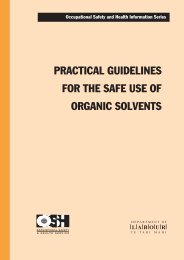
![Task analysis worksheet [161 KB PDF] - Business.govt.nz](https://img.yumpu.com/51400981/1/190x135/task-analysis-worksheet-161-kb-pdf-businessgovtnz.jpg?quality=85)

